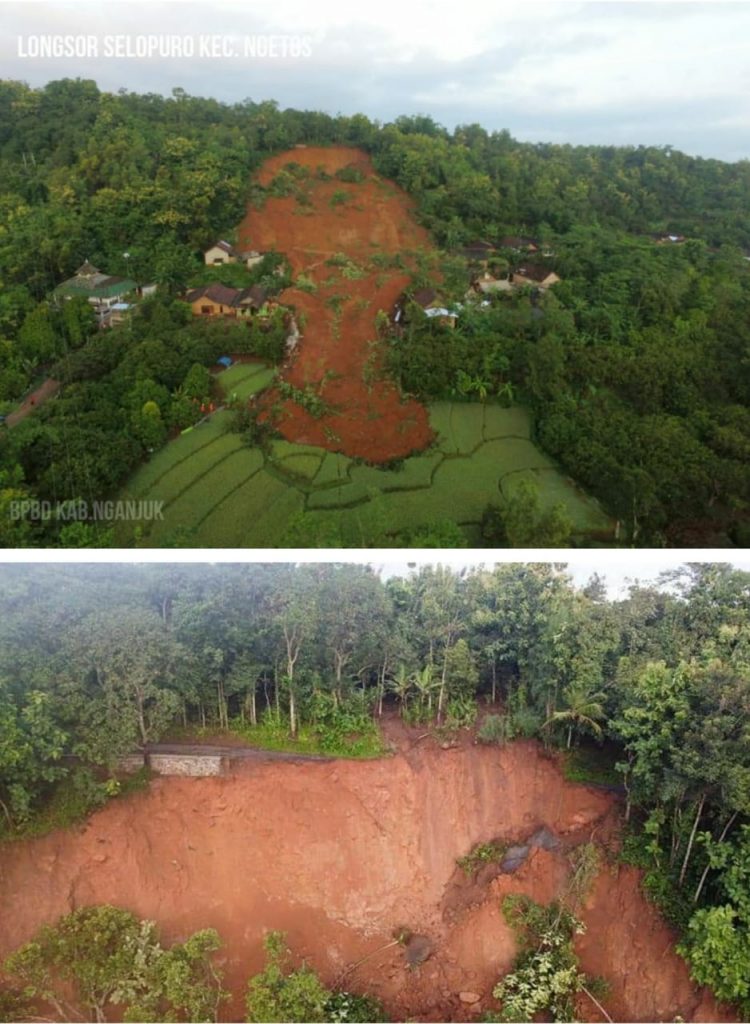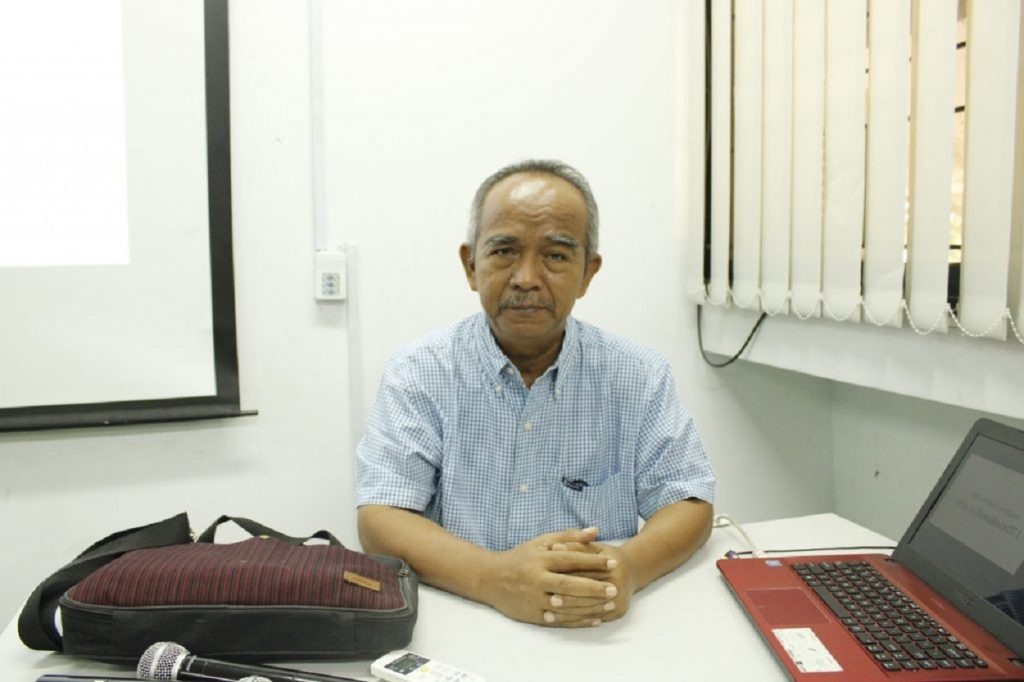ITS Disaster Researcher Gives Opinion on the Nganjuk Landslide Cause

Mahkota landslide in Ngetos Village, Nganjuk, shows its thick soil layer and short vegetation roots.
ITS Campus, ITS News – Hydrometeorological disasters are a type of disaster that often occur in Indonesia, including the beginning of 2021. Some of the tragedies that have happened at the height of recent climate change are floods and landslides. After a landslide occurred in Sumedang Regency, West Java, the recent landslide evacuated Ngetos Village residents, Nganjuk Regency.
Disaster researcher from the Research Center for Disaster Mitigation and Climate Change (MKPI) Institut Teknologi Sepuluh Nopember (ITS), Dr. Ir Amien Widodo MSi, gave his scientific opinion regarding this matter. With the hope that it can be used as a joint lesson in the future.
Data on Saturday (20/2) spoke of a landslide that hit Ngetos Village, Nganjuk, leaving 101 residents displaced at the 3 Ngetos Public Elementary School (SDN) 3. The National Disaster Management Agency (BNPB) noted that the landslide claimed the lives of 12 residents, 20 others were injured, and affected 186 other residents.

Senior Researcher from ITS Research Center for Mitigation, Disaster and Climate Change (MKPI), Dr. Ir Amien Widodo Msi
Amien did not tire of reminding that statements alleging heavy rain as the cause of floods and landslides were less educational and should be corrected. “The reason is, almost every hydrometeorological disaster occurs. The government states that rain is the trigger,” he said.
In fact, according to Amien, rain is only one factor that has led to a hydrometeorological disaster, such as the recent landslide that hit Nganjuk. “If it continues to blame the rain, future generations will not learn from their mistakes and will only make the same mistakes,” he said.
He continued that almost everyone has studied the characteristics of objects’ motion on an inclined plane while in school. The item can move when the bond factor, more commonly referred to as friction, decreases or decreases. “Another reason is because of the additional load on the object, as well as the increase in the inclination angle of the inclined plane,” he added.
As with landslides, soil movement is more prone to occur on sloping mountain slopes. Land attached to a mountain slope is analogous to an object on an inclined plane. If the loading does not increase in weight and the inclination angle is far from the critical point, the possibility of soil movement or landslide will be reduced.
“The mountain soil is formed due to a weathering process that is influenced by climate, topography, rocks, vegetation, and time,” continued Amin. Climate, stormy and hot, can accelerate the weathering process. Indonesia’s tropical climate can then trigger rock weathering to occur more frequently so that the soil in Indonesia has a thicker layer than others.
As time went on, the mountain soil thickened, and the trees got bigger. The roots of the trees play a role in holding the ground so that landslides do not occur. “The overloading can be held back, and the land becomes more stable because it is not easy to shift any more,” continued the lecturer who graduated from UGM.
Based on the principle of motion of objects on an inclined plane, according to him, the mountain soil’s stability can turn unstable for several reasons. “First, the reduction of vegetation is one of the causes of soil instability,” he said. Ideal and stable conditions exist when the root fibers improve soil cohesion, while the supporting roots become armature or nails in the supportive rock underneath.
As is still the case, the loss of vegetation is mainly due to logging—both legally and illegally (illegal). Besides, it can be lost due to forest fires. “Either naturally or deliberately burned, both have an impact,” he said. And not infrequently, trees collapsed due to the strong winds.
Second, soil stability can be compromised by cutting the slopes at the bottom. This is because Amien explained that the slope angle could be increased due to the cutting. Thus, the soil layer will get closer to a critical position, aka not ideal. Naturally, these cuts can occur due to erosion by river flows or previous landslides.
“However, don’t forget that activities such as mining, tunneling, and house widening, for example, can also accelerate the soil layer on the slope to near its critical point,” he warned.
The third cause of soil instability is the continuous addition of loads, thus adding to the soil layer’s weight. The addition of load can naturally occur due to hoarding landslides. However, from Amien’s point of view, most of them are caused by human activities such as hoarding land for settlement development or misuse of slopes as garbage dumps.
Fourth, soil instability can occur due to the addition of water content. Generally, this addition often happens when it rains continuously for several hours. However, water loading can also be contrived, such as by providing ponds and rice fields. “Including the seepage of the septic-tank can add to the heavy water burden that the land must bear,” he explained.
The more water the soil depends on, the smaller the ground’s binding capacity (cohesion). “The lower the soil cohesion, the more saturated the soil properties and the more susceptible to landslides,” he continued.
It is not enough here. The cause mentioned by Amien is fifth, namely vibrations, which can change or untie the bonds between soil grains. Beats that may hit the ground, for example, earthquakes that occur naturally or vibrations caused by heavy vehicles and trains that appear, are still under human control.
Apart from the five above, Amien said that soil weathering is the last cause affecting soil stability. Weathering of the soil, which causes chemical processes in the ground, such as leaching of soil-binding compounds/elements and translocation of clay minerals, can reduce the strength of the bonds between the materials that make up the soil. However, these factors require more detailed research and assessment using physical, chemical, and biological analyzes.
“As we have mentioned above, the water factor such as rain is only one contributing factor. Meanwhile, the causes of landslides are generally a combination of these factors, “said Amien. As a complement, Amien opened the study results by the Center for Volcanology and Geological Disaster Mitigation (PVMBG) of the Geological Agency, which came to the location.

Posters that illustrate the factors that cause and trigger landslides
The PVMBG analysis results state that several factors that have been recorded as the cause of landslides include steep slopes and former mining areas (landslides in Cimanggung, Cihanjuang), thickly weathered soil, lack of vegetation, loose volcanic deposits, rare soils. and quickly decays in contact with water (landslide in Ngetos, Nganjuk). (ITS Public Relations)
Reporter: Kafa ‘Aisyana Ni’mah
Related News
-
ITS Collaboration with BPBD East Java, Launching VR Disaster Simulation
ITS Campus, ITS News — Supporting anticipation of disasters and continuing to educate the public, Institut Teknologi Sepuluh Nopember
February 24, 2021 16:02 -
Supporting the Implementation of Innovative Ideas, ITS and IYSA Hold International Competition
ITS Campus, ITS News — Institut Teknologi Sepuluh Nopember (ITS) has once again proven its commitment to supporting the
February 24, 2021 16:02 -
ITS Maintains Informative Qualification for Five Consecutive Years at KIP Awards
ITS Campus, ITS News — Institut Teknologi Sepuluh Nopember (ITS) has once again successfully maintained its Informative Qualification predicate
February 24, 2021 16:02 -
ITS Strengthens Smart Eco-Campus through UI GreenMetric 2024
ITS Campus, ITS News — Institut Teknologi Sepuluh Nopember (ITS) has once again demonstrated its commitment to environmental concern
February 24, 2021 16:02
